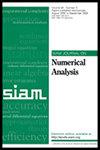How Sharp Are Error Bounds? –Lower Bounds on Quadrature Worst-Case Errors for Analytic Functions–
IF 2.9
2区 数学
Q1 MATHEMATICS, APPLIED
引用次数: 0
Abstract
SIAM Journal on Numerical Analysis, Volume 62, Issue 5, Page 2370-2392, October 2024.Abstract. Numerical integration over the real line for analytic functions is studied. Our main focus is on the sharpness of the error bounds. We first derive two general lower estimates for the worst-case integration error, and then apply these to establish lower bounds for various quadrature rules. These bounds turn out to either be novel or improve upon existing results, leading to lower bounds that closely match upper bounds for various formulas. Specifically, for the suitably truncated trapezoidal rule, we improve upon general lower bounds on the worst-case error obtained by Sugihara [Numer. Math., 75 (1997), pp. 379–395] and provide exceptionally sharp lower bounds apart from a polynomial factor, and in particular we show that the worst-case error for the trapezoidal rule by Sugihara is not improvable by more than a polynomial factor. Additionally, our research reveals a discrepancy between the error decay of the trapezoidal rule and Sugihara’s lower bound for general numerical integration rules, introducing a new open problem. Moreover, the Gauss–Hermite quadrature is proven suboptimal under the decay conditions on integrands we consider, a result not deducible from upper-bound arguments alone. Furthermore, to establish the near-optimality of the suitably scaled Gauss–Legendre and Clenshaw–Curtis quadratures, we generalize a recent result of Trefethen [SIAM Rev., 64 (2022), pp. 132–150] for the upper error bounds in terms of the decay conditions.
误差界限有多精确?-解析函数的正交最差误差下限--
SIAM 数值分析期刊》第 62 卷第 5 期第 2370-2392 页,2024 年 10 月。 摘要研究了解析函数实线上的数值积分。我们主要关注误差边界的尖锐性。我们首先推导出最坏情况积分误差的两个一般下限估计,然后应用这些估计建立各种正交规则的下限。这些下限要么是新颖的,要么是对现有结果的改进,从而使下限与各种公式的上限非常接近。具体地说,对于适当截断的梯形规则,我们改进了 Sugihara [Numer. Math., 75 (1997), pp.此外,我们的研究还揭示了梯形法则的误差衰减与 Sugihara 的一般数值积分规则下限之间的差异,从而引入了一个新的开放性问题。此外,在我们考虑的积分衰减条件下,高斯-赫米特正交被证明是次优的,而这一结果不能仅从上界论证中推导出来。此外,为了确定适当缩放的高斯-勒根德和克伦肖-柯蒂斯正交接近最优,我们推广了 Trefethen [SIAM Rev., 64 (2022), pp.
本文章由计算机程序翻译,如有差异,请以英文原文为准。
求助全文
约1分钟内获得全文
求助全文
来源期刊
CiteScore
4.80
自引率
6.90%
发文量
110
审稿时长
4-8 weeks
期刊介绍:
SIAM Journal on Numerical Analysis (SINUM) contains research articles on the development and analysis of numerical methods. Topics include the rigorous study of convergence of algorithms, their accuracy, their stability, and their computational complexity. Also included are results in mathematical analysis that contribute to algorithm analysis, and computational results that demonstrate algorithm behavior and applicability.

 求助内容:
求助内容: 应助结果提醒方式:
应助结果提醒方式:


